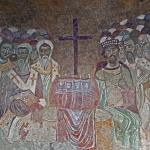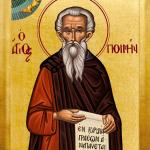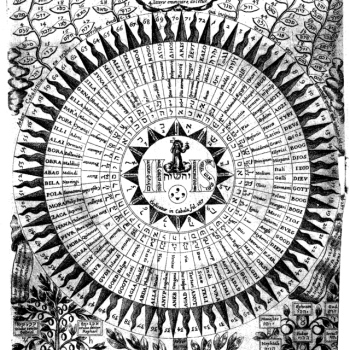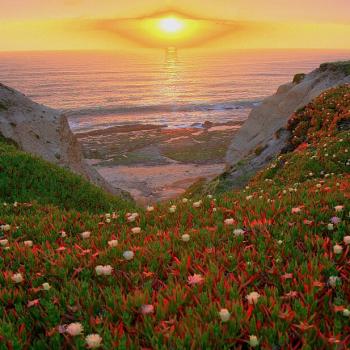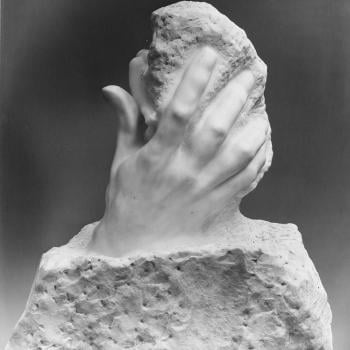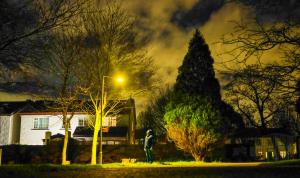
When we are told that humanity is made in the image and likeness of God (cf. Gen. 1:27; Wis. 2:23), we should not think that this means only humanity is made in the image and likeness of God. To think this is an exclusive claim is a mistake so many make. Granted, it is not heresy to think this, and so Christians can believe this if they wish, but they would be wrong to do so. Everything was made, in their own unique and differing way, in the image and likeness of God. Those who properly engage their spiritual senses will be able to see God revealed in and through all things. For this to be possible, God’s image needs to implanted in all things. Nonetheless, we must remember, just as there are many different ways to paint the same subject, so the image and likeness of God, due to God’s transcendent nature, can be imagined in an infinite variety of ways.
Nicholas of Cusa suggested that God can be considered as the defining factor which not only defines itself but which gives everything else its own definition. It is, in this way, the definition which defines all definitions, and every intellect, in perceiving the definitions or essences behind all things, seeks after it: “The definition which defines itself and all things is the definition which every mind seeks.”[1] This is one way we can come to know the image of God as it is revealed in all things. Everything has its own definition, its own essence, and by that definition it finds itself in the image and likeness of the Definition from which it came. This is similar to what St. Maximos the Confessor pointed out in his writings when he said that everything made in and through the Logos has its own logos which thus points to the Logos from which it was made (with the realization, of course, that the Logos is God).
Nicholas of Cusa also explained that the way God is imagined in each and every thing is in accordance with the potential given to it, so that some things better imagine God than others because they have greater potential than others:
If anyone sees how it is that be defining itself Not-other defines all things, he sees that Not-other is the most congruent measure of all things – a greater measure for greater things, a lesser measure for less things, an equal measure for equal things, a beautiful measure for beautiful things, a true measure for true things, a living measure for living things, and so in in the same way for all things. [2]
Thus, while it is important for us to know and realize that we are in the image and likeness of God, what we should try to discern is how we imagine God, how God is represented in and through our nature or logos. We should not try to assert that we alone are made in the image of God. We should, instead, try to understand that the way we represent the image is unique, and likewise, it is in the qualities and characteristics associated with the way we imagine God which makes us fit for the incarnation. While we might try to speculate on what those characteristics are and explore them in a variety of ways, we must also appreciate the fact that the incarnation is a mystery; we must humbly accept that our speculations are just attempts to make sense out of the mystery itself. What is important is that God gave humanity a purpose and mission which connected to the way humanity imagined and presented God to the rest of creation, a way which was most fitting for the execution of the divine plan and to become incarnate in creation.
While recognizing that God’s image and likeness has been implanted in all things, we must also follow the apophatic no and also discern the way God is not similar to anything in creation. Just as God can be said to be the Definition which gives everything its own definition, and through this discern that everything possesses its own image of God within, God, in accordance to the divine nature, is beyond all Definitions, making God similar to nothing at all. All things come from God, not through the essence of God, but through the divine energies. All things relate to God and point to God through those energies, while the essence or nature of God (conventionally speaking) remains infinitely beyond us. This paradox is explained well by Pseudo-Dionysius:
The theologians say that the transcendent God is inherently similar to no other being, but then he also bestows a similarity to himself on all those who are returning to him in imitation as far as possible, of what is beyond all definition and understanding. It is the power of the divine similarity which returns all created things to their Cause, and these things must be reckoned similar to God by reason of the divine image and likeness. But we cannot say that God is similar to them, any more than we can say that man is similar to his own portrait. Things on the same level may be similar to one another with the result that similarity can be predicated of either of them. And they can be similar to each other through the workings of a prior form of similarity which thy share. But an interchange of this sort cannot be admitted in regard to Cause and effects, for God does not grant similarity merely to some objects. He is in fact the Cause of this in all that have the quality of similarity. He is the subsistence of absolute similarity, and all the similarity in the world is similar to a trace of the divine similarity so that all creation is thereby made a unity.[3]
God is the Creator; God has the title of Creator due to the divine activity or energy revealed in the act of creation,. It is also through this energy we are able to know God as God, as the transcendent one who is beyond all our comprehension. It is the divine energy revealed in the act of creation which leaves a trace of itself in and through all creation, allowing us to see and discern the image and likeness of the Creator in all things. There are many more ways by which we could discuss the relationship between the divine energies, what they reveal about God, and what is found in creation, so as to find more ways in which the image and likeness of God is revealed in creation. Perhaps the three most important are the divine energies associated with being, beauty, and goodness. They each reveal the glory of the divine nature, and each of them can be found reflected and represented in all things, each in their own particular way. The potential, the level of being, in each thing will differ, allowing for the differentiation of the various essences found throughout creation, but they will all find themselves redirected back to God according to the way they have been formed in the image and likeness of God. And because they share similarity with God with each other, all things in their own way are similar to each other. Thus, as Dionysius pointed out, it is through such similarity all things can be brought together and joined together as one, showing in and through their unity another way in which God can be and is imagined in creation.
Humanity is made in the image and likeness of God. It is unique in the way it presents that image, just as every other species of life, just as every other essence or form in existence, presents God in their own unique way. We can and should value our uniqueness, but we should also value and appreciate the uniqueness of everything else in creation. We should appreciate how everything in creation can and does present something of the glory of God to us. We do not need to feel our own uniqueness is threatened by this realization. Rather, it means we should explore other avenues as to what that uniqueness means, allowing us to appreciate it that much more than we did before.
[1] Nicholas of Cusa, On God as Not-Other: A Translation and Appraisal Of De Li Non Aliud. Trans. Jasper Hopkins (Minneapolis: University of Minnesota Press, 1979), 141.
[2] Nicholas of Cusa, On God as Not-Other: A Translation and Appraisal Of De Li Non Aliud, 143.
[3] Pseudo-Dionysius, “The Divine Names” in Pseudo-Dionysius: The Complete Works. Trans. Colm Luibehid (New York: Paulist Press, 1987), 117-8.
Stay in touch! Like A Little Bit of Nothing on Facebook. If you liked what you read, please consider sharing it with your friends and family!


